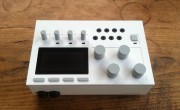By Brian Kecskemety
This week I got a chance to sample the new Logitech Ultimate Ears Ultimate Ears 9000 – the top tier in Logitech’s line of over-the-ear headphones. These noise-canceling phones feature wireless connectivity via Bluetooth, and unlike some other noise-isolating phones, the ambient-reduction feature doesn’t need to be turned on – the UE 9000s are always actively canceling out surrounding noises to to help the listener focus on the music. That coupled with the over-the-ear design, outside sounds were not a distraction, even when playing music at lower volumes. However, there is some noticeable bleeding – if you’re playing music at even a moderately loud level, someone else nearby might be able to hear it. If you’re looking for headphones to blast guilty pleasure music at your cubicle desk, you may want to look elsewhere.
Setting up the Bluetooth with my MacBook Pro was a breeze, and the advertised battery life (10 hours of wireless listening) seemed to be accurate. The UE 9000 includes two ways to affect volume and select music – via the remote on the analog audio cord or via buttons on the actual headphone itself. Unfortunately, only one of these methods will work at a time. If you’re listening via analog, the cord remote will work for you, but not the controls on the headphone. Vice versa if you’re listening via Bluetooth. Also keep in mind that the pause/play button will operate native Apple apps like iTunes or Quicktime, but not other audio players like Spotify, which is surprising since Spotify will respond to the pause/play buttons on the MacBook Pro keyboard.
While the UE 9000s are supposedly “made for” iOS devices, I had no problems connecting these headphones to my (now ancient) Motorola Droid 3. The volume and play/pause controls worked (including with Spotify!) and the transition to taking an incoming phone call was seamless. The included mic on the UE 9000 worked well enough to carry a phone conversation. For both the MacBook Pro and the Droid 3, the wireless range worked up to around 50 feet.
So basically, they work. But how do they sound?
In a word, very good. The UE 9000s have a wide stereo image and a nice round bass response. As a result music sounded powerful without drowning out or overshadowing the vocals, which remained crisp. I’ve noticed a tendency with newer consumer headphones to over-emphasize the bass, but the response with these always felt true to the original mix.
While wireless connectivity is one of the UE 9000s more boasted features, (and the primary way it differentiates itself from its cheaper cousin, the UE 6000), the optimal listening experience with these headphones will come via the included analog cord. Even sitting a few feet away from my computer, there was the occasional pop and click when listening via Bluetooth, enough so that when possible, I would stick with the cord. Additionally, while listening while charging the headphones (via included USB cable), there was very noticeable additional noise, particularly when the cable was agitated. If you’re planning a marathon listening session, (or even if you’re not), it’s best to keep these phones fully charged at all times.
Marathon listening sessions might be physically taxing, as there is a fair amount of fatigue – not in the ears, but in the head. These phones, while fitting snugly, are also heavy, and you might need a quick breather every so often.
The Logitech Ultimate Ears 9000 Wireless Headphones retail for $400. Not a bad value, though if you don’t need the wireless feature, you may want to check out the UE 6000s.
- WIRELESS RANGE: 50 feet (15 meters)
- HEADPHONE TYPE: Around-the-ear
- DRIVER DIAMETER: 40mm
- IMPEDANCE: 32 ohms, 1 kHz
- SENSITIVITY: 105 dB SPL/mW, 1 kHz
- FREQUENCY RESPONSE: 20 Hz – 20 kHz
- CONNECTION: Bluetooth or 3.5 mm (1/8 inch)
- NOISE ISOLATION: 14dB
- BATTERY TYPE: rechargeable battery pack (included)
- BATTERY LIFE: over 20 hours of listening with analog input, over 10 hours of listening with wireless connection



![[Interview] With Their Stunning Crystallized Volcano, Krewella Hopes to Blow Fans’ Minds](http://www.soundctrl.com/blog/wp-content/uploads/2013/09/Identity_Set-180x110.jpg)
![[Interview] Stefan Du Toit, CSO of Fancam](http://www.soundctrl.com/blog/wp-content/uploads/2013/08/tswift_11-180x110.jpg)
![[Interview] Billy Chasen, Co-Founder of Turntable.fm, Discusses Turntable Live](http://www.soundctrl.com/blog/wp-content/uploads/2013/10/Screen-Shot-2013-10-09-at-2.33.34-PM-50x50.png)
![[Interview] Matt Loszak, Founder of JamCam](http://www.soundctrl.com/blog/wp-content/uploads/2013/10/Slide11-50x50.jpg)








Comments are closed.